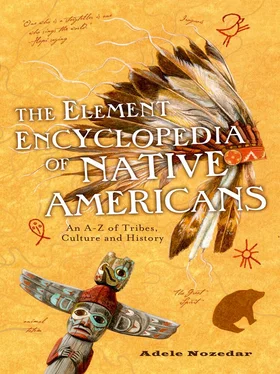The Catawba were an agricultural tribe and, in common with other Indian peoples who enjoyed a stable existence, were able to devote time to experimenting with basketwareand pottery. Huntingand fishing supported their farming endeavors.
In terms of religion, the Catawba believed in a trinity of the Manitou(or creator), the Kaia (or turtle), and the Son of the Manitou. It’s possible that this idea of a trinity was influenced by the beliefs of the Christian faith of the white settlers. When the Mormons visited the tribe in the 1880s, several members of the Catawba converted, and some even relocated to Utah.

“I have, for many years past, contemplated the noble races of red men who are now spread over these trackless forests and boundless prairies, melting away at the approach of civilization.”
1796–1872
Arguably the most famous painter of the Native American, Catlin’s writings as well as his paintings provide a rich heritage of information about the indigenous peoples of America, invaluable in that Catlin lived closely among them, studying their customs and habits, languages, and ways of living.
Born in Pennsylvania, although he was trained as a lawyer Catlin opted out of the legal profession quite early on in favor of art, and set up a portrait studio in New York. In common with others, Catlin rightly suspected that the Native American and his way of life were endangered, and so he decided to dedicate his life to the study of the people.
He published two significant volumes of Manners, Customs and Conditions of the North American Indians , replete with 300 engravings, in 1841. In 1844 another book followed: The North American Portfolio contained 25 color plates, reproductions of his paintings. These books are still in print today.
Catlin’s mother inspired his continuing fascination with the Native people of his country. When he was a child she regaled him with stories of how she’d been captured by a band of Indians as a little girl, which no doubt stimulated his childish imagination. Catlin’s appetite for recording the lives of the Native Americans, a passion which led to his giving up a “proper” career, was further excited when he witnessed a delegation of Native Americans passing through Philadelphia.
In 1830 he joined General William Clark on his expedition up the Missouri. Basing himself in St. Louis, Catlin managed to visit at least 50 different tribes, and later traveled to the North Dakota—Montana border, where the tribes—including the Mandan, Pawnee, Cheyenne, and Blackfeet—remained relatively untouched by the encroaching Europeans. When he returned home in 1838, he assembled his works—which included some 500 paintings of Native Americans and their way of life—into his “Indian Gallery.” He also included artifacts in the exhibition.
Catlin lectured extensively about his experience, and in 1839 took the Indian Gallery exhibition on tour of the major European capitals—Paris, London, and Brussels. However, none of this generated an income and Catlin was forced to seek a buyer for his work. He was desperate to keep his life’s work intact, and spent some time trying to convince the U.S. Government to purchase the entire collection, but in vain. Eventually, he sold the entire collection of 607 paintings to a wealthy industrialist, Joseph Harrison, who put it into safe storage. In 1879, after he died, Joseph Harrison’s widow donated the Indian Collection, a deal of which had suffered the ravages of time and were mouse-eaten and damp, to the Smithsonian Institution, where Catlin had worked for a year just before his death. It remains a part of the Institution’s collection.

The traditional game played by two or more children, who “weave” a loop of string in and out of each other’s hands. Traditionally played by the Navajoand Zunipeoples.
One of the five original tribes of the mighty Iroquois Confederacy( Haudenosaunee), the name Cayuga means “People of the Great Swamp” or else “People of the Mucky Land.”
During the Revolutionary War, the Cayuga had fought on both the British and the American sides; however, the majority of the Iroquois elected to support the British in the hopes that a British victory would put an end to encroachment by the settlers onto Native territories. The power of the Iroquois posed a real threat to the plans of the Americans, and in 1779 the future president, George Washington, devised a military campaign specifically aimed at the Confederacy. Over 6,000 troops destroyed the Cayuga’s ancestral homelands, razing some 50 villages to the ground, burning crops so that the people would starve, and driving the survivors off the land. Many of the Cayuga, along with other tribes, fled to Canada where they found sanctuary and were given land by the British in recognition of their aid. Although the Seneca, the Iroquois, the Oneida, and the Onondagatribes of the Confederacy were given reservations, the Cayuga were not. Earlier, however, small bands of Seneca and Cayuga had relocated to Ohio, and many other Cayuga joined them because they had no home. The Cayuga—along with the rest of the Haudenosaunee—signed the Treaty of Canandaigua in 1794, which ceded lands to the new United States Government. Thereafter, the floodgates opened for the former Cayuga lands, and settlers arrived there in droves.
Of the Penutian language group, the original meaning of the word Cayuse has been lost in the mists of time. However, because of the tribe’s particular skill in breeding horsesand also in dealing them, their name has become synonymous with that of a particular small pony that they bred. The Native American name of the Cayuse is Waiilatpu . Associated with the Nez Perceand Walla Walla, the Cayuse lived along the Columbia River and its tributaries from the Blue Mountains as far as the Deschutes River in southeast Washington and northeast Oregon.
The Cayuse lived in a combination of circular tentlike structures and rectangular lodges. Extended families made small bands, each with its own headman or chief. The horses that became such an important part of the life of the tribe were introduced to them in the early part of the 18th century. Trading was not restricted to horses, though; the Cayuse bartered with the coastal tribes items such as buffaloblankets for shells. Later, they would trade with the white men: furs for gunsand tools.
The Cayuse War of 1847–1850 was ignited by an outbreak of one of the European diseases for which the Native American tribes had no immunity: measles. The disease was first contracted by the Cayuse children who attended the mission school, and it spread to the adults.
The people who had started the mission school were not popular, and it seems that they had made little attempt to establish good and meaningful relationships with the Cayuse, with whom they had lived and worked for ten years. Marcus Whitman and his wife, Narcissa, were Presbyterians and had started the Waiilatpu Mission in 1836. The couple took little notice of the traditional ways and customs of the Cayuse and were zealous in their pursuit of converts. Moreover, it was rumored that they had made money for themselves from resources which should have belonged to the Cayuse: furs and land sales.
Читать дальше














